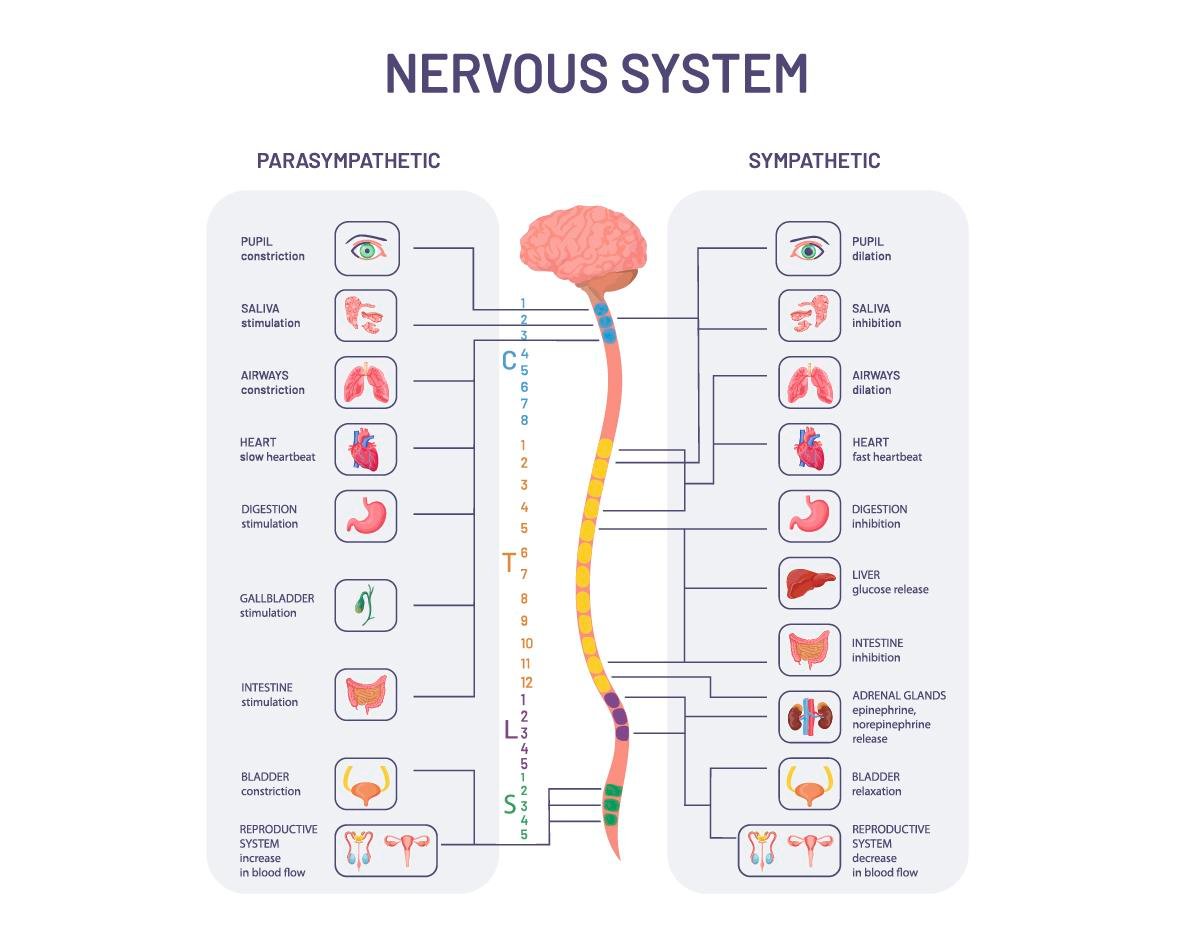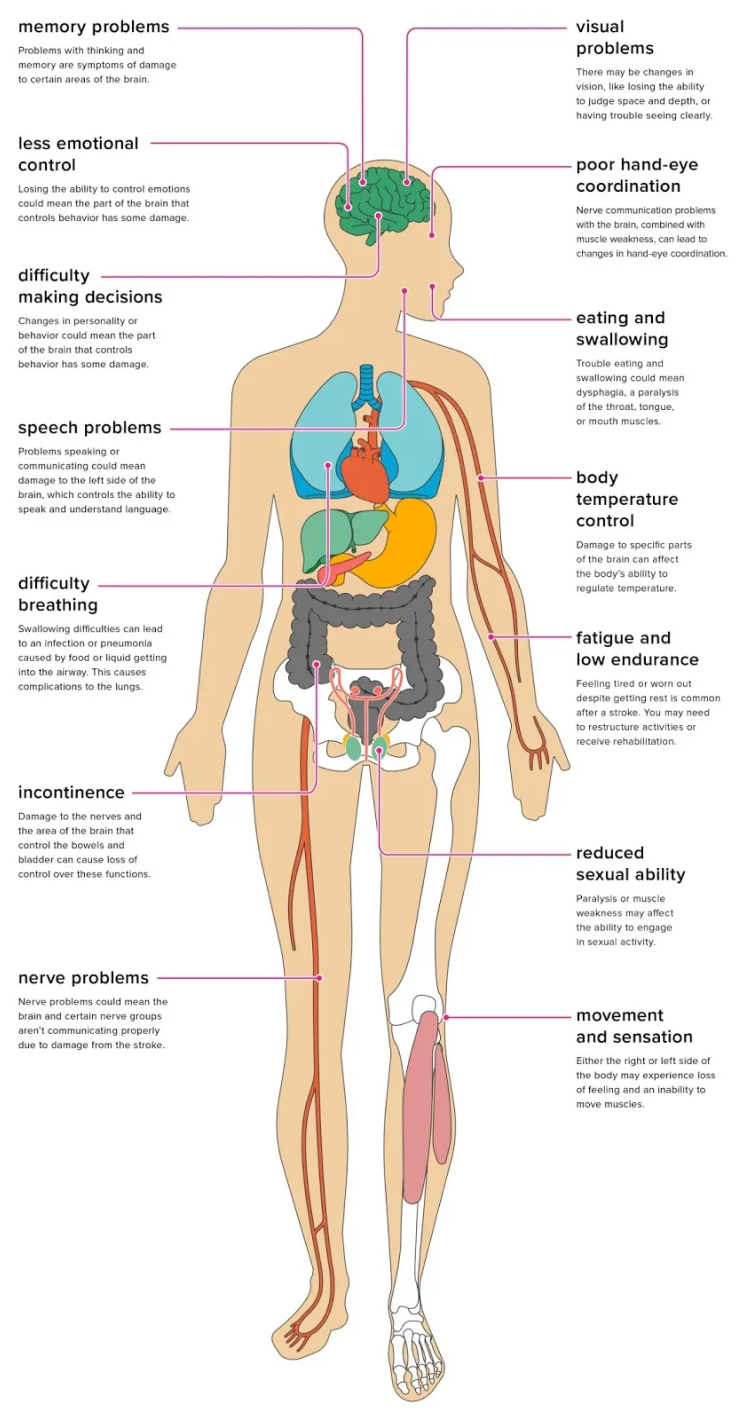Fundamental principles in Homoeopathy
Homoeopathy adheres to two fundamental principles in prescribing medicines: the minimum dose and the single dose. The concept of the minimum dose is rooted in the understanding that a subtle stimulus from the medicine initiates the intrinsic healing response. Following this principle, the medicine is administered in just enough quantity to kickstart the body's natural healing mechanisms. This response, driven by the body's innate need to maintain health and balance, continues without producing the pronounced side effects often associated with conventional treatments.
The minimum dose principle aligns with the Arndt-Schultz law, named after pharmacologist Hugo Schultz and psychiatrist Rudolf Arndt. According to this law, weak stimuli accelerate vital activity, medium stimuli slightly raise it, strong stimuli suppress it, and very strong stimuli halt it. In simplified terms, small doses stimulate, medium doses inhibit, and large doses can be detrimental. Homoeopaths employ the minimum, potentized dose to harness the subtle yet effective impact on the body.
When consulting a homoeopath for the first time, patients may be surprised to receive just a single pill, especially if accustomed to multiple medications from conventional doctors. The rationale behind the single dose is rooted in the ability of homoeopathic medicine to stimulate the internal healing mechanisms of the body. Observing and allowing these mechanisms to operate obviates the need for additional doses. Although there may be a slight aggravation of symptoms initially, this is typically followed by improvement as the medicine stimulates vitality and strengthens the immune system. In chronic diseases, old symptoms that might have been previously suppressed may resurface during the healing process.
Several reasons support the practice of giving only one medicine at a time in homoeopathy:
- Avoiding Interference: Multiple medicines could potentially cancel out each other's actions.
- Identifying Effective Remedies: Administering a single medicine allows for a clear understanding of its impact without confusion from simultaneous remedies.
- Preventing Unknown Interactions: The possible interactions between concurrently given remedies are not fully understood.
Homoeopathy is committed to treating the whole person rather than isolated symptoms. This holistic approach underscores the mission to find the one medicine that aligns with the entire case. The emphasis on holistic healing is central to the principles of minimal dosage in homoeopathy, ensuring a nuanced and personalized approach to healthcare.
has context menu. This is the reason why holistic approach is required in homoeopathy.
Brain
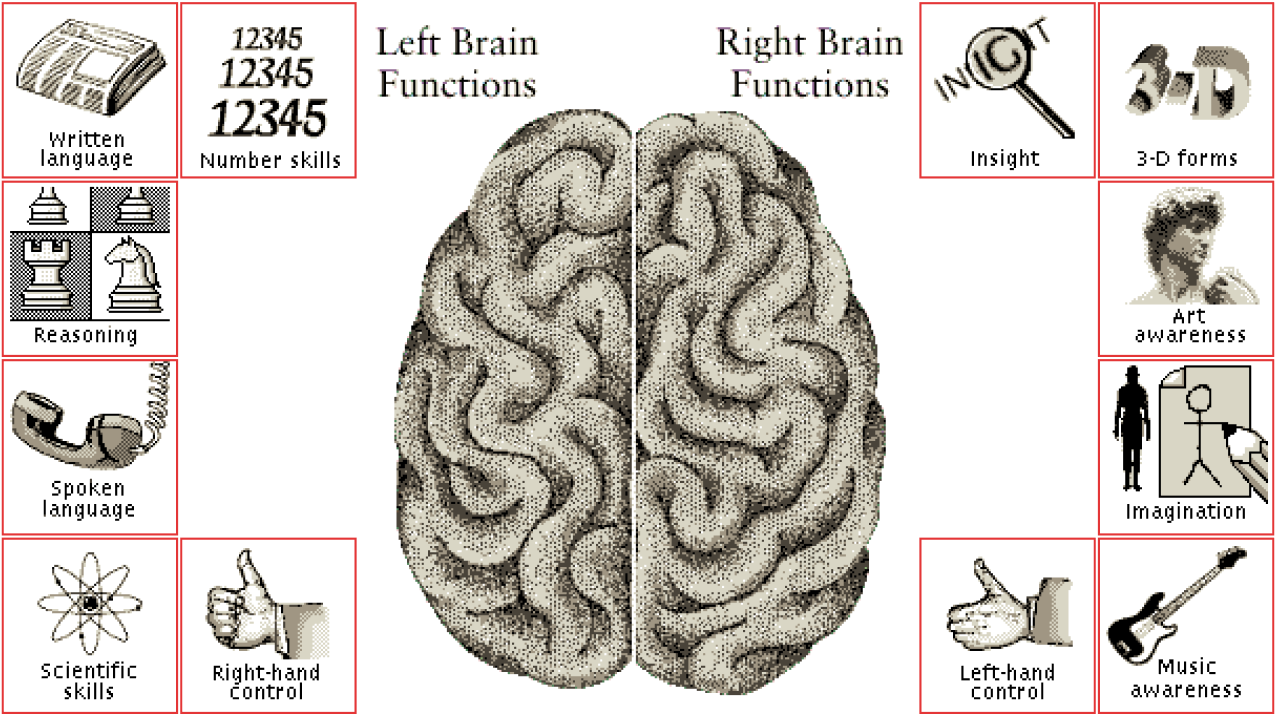
- Executive management part of the brain that forms a judgement from all of the information that has been sent from around the brain
Definition of Temperament:
Temperament is the amalgamation of mood, thoughts, and subsequent actions—an intricate psychological response to various situations. Introduced by Hippocrates around 400 B.C., this concept stems from the belief that the body comprises four humors: Blood, Phlegm, Yellow bile, and Black bile. These humors, representing bodily fluids metaphorically associated with specific emotions, were considered imbalances leading to various diseases. Temperament, therefore, reflects the distinctive combination of bodily, mental, and moral qualities shaping an individual's character and predisposing them to act in specific ways.
Types of Temperaments:
Sanguine Temperament
Spontaneous and optimistic, individuals with a Sanguine temperament infuse energy into any situation, lighting up the mood and bringing vibrancy to gatherings. They are extroverts, daydreamers, and social butterflies.
Weakness:
Tendencies toward impulsiveness, distractibility, and avoidance of routine or long-term commitments. Instability and inclinations toward flirtation, envy, and jealousy.


Choleric Temperament
The fiery Choleric temperament is goal-oriented, surpassing targets and creating opportunities unapologetically. Natural leaders, they exhibit decisiveness and fastidiousness in their pursuits.
Weakness:
Displays of impatience, irritability, and a tendency to be controlling or dominating in interactions. Tendencies toward being unemotional, deceitful, disguising intentions, and engaging in hypocrisy.
Melancholic Temperament:
The Melancholic temperament values logic and consistency, striving for perfection in all endeavors. Organized and thoughtful, they are responsible and self-sacrificing individuals who take work seriously.
Weakness:
Potential manifestations of moodiness, depression, and excessive self-criticism or pessimism. Tendencies to be unforgiving.


Phlegmatic Temperament:
Patient and supportive, the Phlegmatic temperament is characterized by a mellow and healing nature. Dependable, easy-going, composed, and thoughtful, they maintain a well-balanced approach to life.
Weakness:
Composition Of Humors
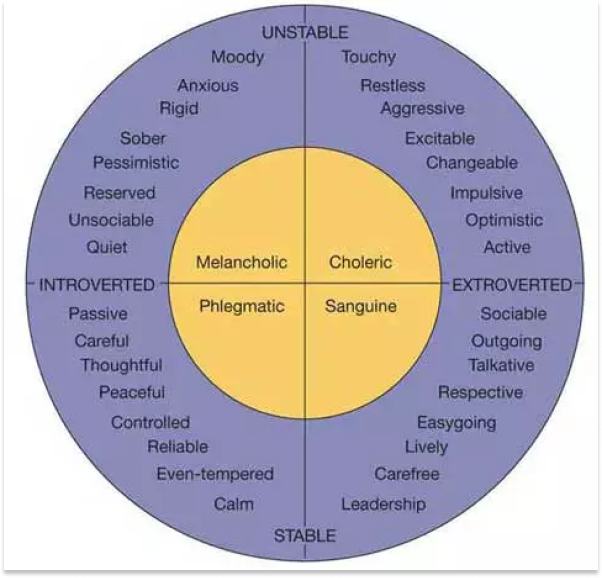
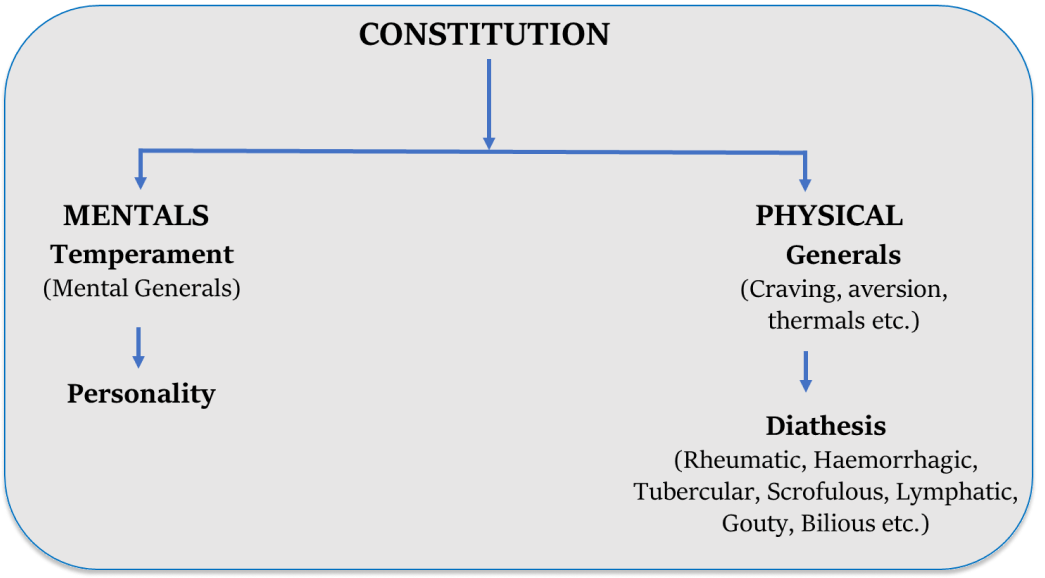
Temperaments Overview:
In summary, temperaments can be categorized as follows:
- Sanguine: Extrovert, Optimistic, Talker
- Choleric: Extrovert, Optimistic, Doer
- Melancholic: Introvert, Pessimist, Thinker
- Phlegmatic: Introvert, Pessimist, Watcher
Understanding these temperaments provides insights into individual predispositions, facilitating personal growth and fostering harmonious interactions. Recognizing both strengths and weaknesses enables individuals to embrace a balanced approach to life, nurturing healthier relationships and personal well-being.
Recognizing these connections emphasizes the importance of addressing emotional well-being for holistic health and the need for a comprehensive approach to both mental and physical care.
Understanding Temperaments and Constitution in Homoeopathy
Temperaments and Personality in Homoeopathy:
In the realm of homoeopathy, understanding temperaments is key. While temperament, defined as the "Real Me," remains constant throughout life, personality is dynamic and subject to change, development, or enhancement. It primarily concerns emotional dispositions and reactions.
Constitution, Diathesis & Temperament:
Constitution: A comprehensive term encompassing physical and mental aspects.
Temperament: An integral part of the constitution, denoting the "emotional climate."
Diathesis: Natural predisposition to disease, a combination of attributes causing susceptibility.
Constitution:
Constitution is the physical and mental makeup revealed through:
- Physical built
- Characteristic desires, aversions, and reactions
- Emotional and intellectual attributes
Homoeopathy Concept:
Dr. Christian Friedrich Samuel Hahnemann, the founder of homoeopathy, classified human constitutions into three groups: Psoric, Sycotic, and Syphilitic. This classification aids in understanding individual tendencies and susceptibilities.
Hippocratic Concept:
Linking physical attributes to health tendencies, e.g., short and thick individuals being prone to apoplectic conditions and long and thin individuals to tubercular affection.


Indisposition and Its Nuances:
Indisposition refers to a mild or minor state of discomfort or illness, often characterized by slight symptoms or a general feeling of being unwell. Unlike full-blown diseases, indisposition represents a subtle deviation from our usual state of health, marked by manageable symptoms that can be addressed through simple adjustments in diet and habits.
This state involves sensitivity, susceptibility, and intolerance, such as situations where one consumes something against their preference at a party. It's essential to recognize that the same causation can affect individuals differently; for instance, indulging excessively in a favored item may lead to varied reactions.
Indispositions often act as acute exacerbations of chronic diseases, exemplified by recurring gastric complaints like diarrhea, vomiting, colic, headaches, chest pains, and more. Each symptom serves as the body's attempt to defend itself, signaling an underlying imbalance.
In summary, understanding and addressing indisposition involve recognizing these subtle signals, making lifestyle adjustments, and acknowledging the body's attempts to restore equilibrium. It serves as a reminder to foster overall well-being and prevent the progression of minor discomfort into more significant health issues.
The Significance of Understanding Constitution
Recognizing the importance of understanding one's constitution is paramount in achieving a constitutional similimum for effective homoeopathic treatment without resorting to suppression. Paracelsus wisely stated, "No knowledge is perfect unless it includes an understanding of the origin – that is, the beginning; and as all man’s diseases originate in his constitution, it is necessary that his constitution should be known if we wish to know his diseases."
The physical makeup of an individual sheds light on various aspects of personality and behavioural patterns. There exists a close link between physical characteristics and the genetic framework, emphasizing the intricate connection between physical and psychic traits. The term "constitution" underscores both physical structure and biological function, comprising inherited qualities molded by environmental influences.
From the moment of conception, a person is endowed with a specific organizational plan shaped by genes and environmental factors. The intrauterine period exposes the developing embryo to various physical and emotional influences from the mother, imprinting certain attributes. Upon entering the world, the individual encounters a new environment, significantly impacting their constitution.
Throughout life, experiences in different environments shape reactions, leading to the formation of likes, dislikes, and attitudes that become integral to one's behavioural pattern. Early environmental influences play a pivotal role in constitution formation, influencing tendencies, attributes, and miasms inherited by an individual.
An individual inherits a distinctive organizational plan, tendencies, attributes, and miasms, determining their pattern of reactions and susceptibility to the environment. Constant adaptation seeks a state of balance to enjoy the environment without discomfort. Imbalances lead to sickness, expressing discomfort, disharmony, and disruption of equilibrium, manifested through signs and symptoms.
The constitution's role is crucial in drug proving and the occurrence of natural diseases. Physicians must comprehend the physical makeup, including build, desires, aversions, and reactions to foods, as well as mental attributes like emotional and intellectual responses. Concomitants related to stressful situations, such as dentition in a child or menstruation, pregnancy, and menopause in a female, are crucial expressions revealing the quality of a constitution.
A constitutional prescription, based on the totality of mental and physical reactions, should encompass susceptibility, tendencies, behavioural patterns, and underlying miasms. This comprehensive understanding facilitates a higher level of similarity between the individual and the medicine, paving the way for effective homoeopathic treatment.


